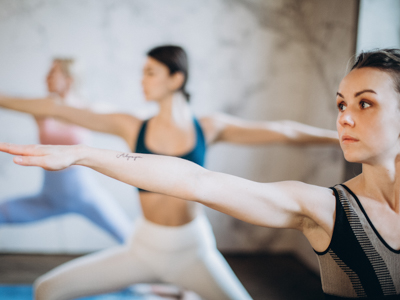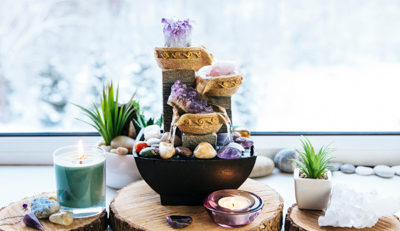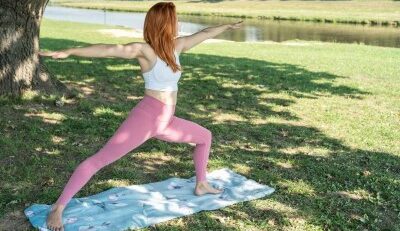10 tips to prepare for your first yoga class
Planning to go to your first yoga class and don’t know what to expect? Are you afraid of embarrassing yourself? Not sure what to bring and what to wear? What if you don’t understand the terms? Fear not. We pulled together 10 simple tips to prepare for your first yoga class. This way you will not only feel more confident, but also get the most out of the lesson.
1. Wear something comfortable
Whilst you can do yoga in practically anything, here are a few tips for a better experience. Yoga clothes should be comfortable. During yoga, you will bend in all direction, twist and transition between positions. You want your clothes to stay in place, show only what you want to show, allow for free movement and breathe.
A sports bra preventing you from ‘falling out’ during inversions (reversed positions) is a must. Stretchy leggings or shorts, preferably with a high waist that do not roll down, cut in or restrict movement are a popular option. Also, fitted tops work best for yoga, preferably sleeveless. It provides freedom of movement for your arms and does not slide down with every bend. For men, leggings or shorts are suitable, but avoid loose shorts that can reveal more than you wish in more open positions.
2. Get familiar with common yoga terms
Unfamiliarity of yoga terms can be an obstacle for many to give yoga a chance. Many come from Sanskrit and their meaning is not obvious at first glance.
With practice, you will learn names of yoga positions, and it is not necessary to know them in advance. Simply observe the instructor and imitate what they do. Same cannot be told for the most common yoga terms. Understanding of these will give you confidence and help you feel more relaxed, navigating your first yoga class without major stress. We put together the 10 most common yoga terms and what they mean so have a look here.
3. Be on time
You don’t need the stress of rushing around, especially not in your first yoga class. Come 10-15 minutes early. This will give you time to fill out any forms, nip to the bathroom and find a good place to put your mat.
It might be tempting to ‘hide’ somewhere at the back, but especially at the beginning you want to have access to the instructor. Try a spot more in front to the side, where you can see the teacher clearly and they can provide you guidance and support as needed. Take a minute to say hallo to the instructor before the class and mention it is your first time, and any limitations or problems you have. They will be able to direct you better during the class, guiding you what to skip and which alternatives are available.
Be early even for online lessons. This will give you time to solve any technical issues, prepare your props, or log-in as needed.
4. Go barefoot
Traditionally, yoga is practiced barefoot. Balance and a sense of grounding are important, and those are achieved best while evenly distributing your weight between all spread out toes. Bare feet on the mat provide a stronger sense of spiritual grounding and transmission of yoga. Regular socks can also be slippery.
While there is a number of non-slip yoga socks, many argue they restrict toe movement, and prevent even strengthening of foot muscles. Furthermore, they weaken the feeling of spiritual grounding.
5. Get your yoga mat and props ready
Some studios lend yoga mats whilst elsewhere you need to bring your own. Call them up beforehand to find out. First few lessons, borrowing a mat is a good option. Once you know your preferences, invest in a good mat that fits you requirements. Read How to choose a yoga mat and what to bring to your first yoga class. Also, as a beginner, it is worth using yoga props such as blocks, straps or bolsters. Studios often have a few to borrow, so pick what you need.
When inside the studio, spread your mat, leaving enough space around for unrestricted movement during the class. If you are not sure what props to prepare, check out other and do as they do.
6. Allow yourself to be a beginner
Leave your ego behind. Yoga is a new experience to you so allow yourself to be a beginner. It is not about a competition or getting into the hardest positions as fast as possible. We all are different, with different flexibility, limitations and built. Yoga shouldn’t hurt, and if you can’t reach the ground with your fingertips, use a yoga block. The benefit of yoga comes from listening to your body and executing positions correctly, without risking injury.
Each asana has several variations from easy to advanced. Focus on getting the basics right and once you laid the foundation, move on to more challenging poses. Trust your instructor. And remember. Child’s pose is always an option.
7. Don’t eat and drink excessively prior and during class
Exercising on a full stomach is generally a bad idea. Yoga is no exception. This includes drinking. Yoga has many inversions, forward bends and positions where the stomach is compressed. This could be not just uncomfortable, but even lead to nausea. Try not to eat and drink excessively prior to your yoga class, and limit drinking during class.
Part of yoga is connecting with your inner self, suppressing external distractions and ‘burning off’ toxins within us. This burning occurs by stimulating the agni, or inner fire. Therefore, Ayurveda recommends not drinking 30 minutes before, after and during the lesson to avoid extinguishing this fire. That doesn’t mean you cannot drink at all. It just means to keep your water intake in check.
8. Relax and breathe
It is hard relax in unfamiliar situations. You might find yourself clenching your teeth, pressing your tongue against top palate, slouching and hiding your head between your shoulders. It is also common to hold our breath when focusing too hard or making physical effort. And yet, conscious breathing is one of the things that distinguishes yoga from other exercises.
During class, focus on your breath, listen to the instructions and try not to hold your breath, but instead breath intentionally. Concentrating on your breath will help you relax, be present in the moment, and more open to the benefits of yoga. It is natural to sometimes forget yourself. The important thing is to realise it, and course correct.
9. Be present in the moment
Yoga is a holistic discipline encompassing physical, but also mental practice. It’s important to be fully present, tuned inwards and consciously experience every movement, breath and sensations that come with it. Only this way will you fully benefit from the class.
Life can be hectic, everyone is fighting their battles and our head is a highway of thoughts. The important thing is to learn not to linger, but rather let them flow by. If you get carried away, just pause, consciously release the thought and continue. Being in the moment takes practice with so many distractions at our fingertips, so don’t be too hard on yourself. It is your first yoga class after all and you will get better at it as you get more practice. Focusing on your breath is a great too to do that.
10. Chant and sing along
Most yoga classes begin in a comfortable cross-legged position, chanting the Mantra Om with closed eyes. This Mantra connects us to the energy in the studio, but also the whole universe. Our mind becomes calmer, and we become open to receive the yoga practice. Depending on the type of class, the teacher can also invite another Sanskrit Mantra. The energy of the mantra affects you whether you actively participate or not. If you do not know the words, don’t let it stop you. Try to repeat what everyone is saying, even if it means making mistakes. The main thing is the intention.
The yoga class ends after Savasana (final relaxation pose lying down} with a greeting. The teacher bows with hands connected at the heart chakra, saying Namaste. The group in the studio responds in the same way and the class is officially ended.
Congratulations for deciding going to a yoga class for the first time. We wish that your first lesson goes smoothly and that you experience many beautiful moments with yoga for years to come. If you have specific questions about going to yoga classes, leave us a comment below. And if you want to receive similar tips regularly, subscribe to NAYAmail. Namaste.







Leave a Reply